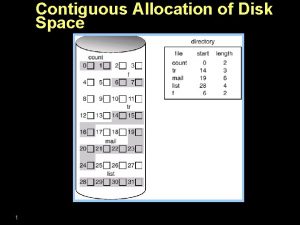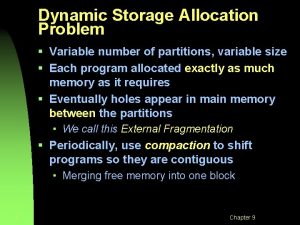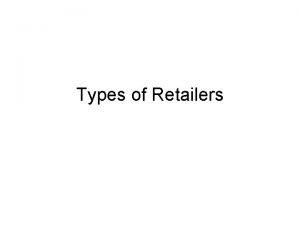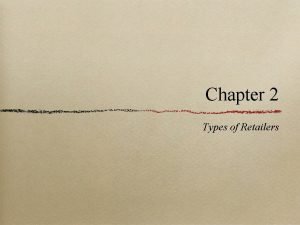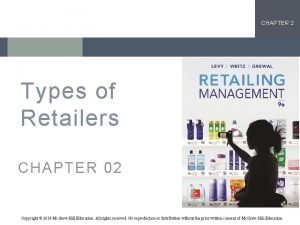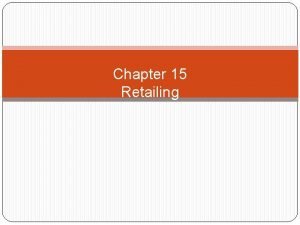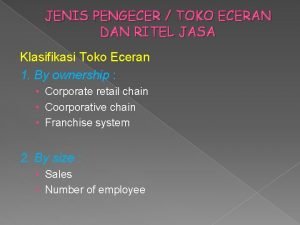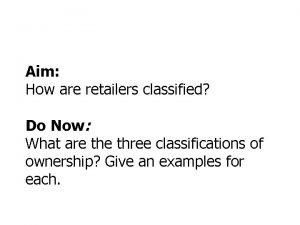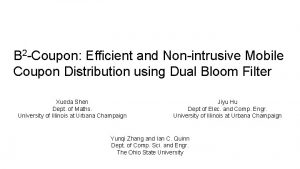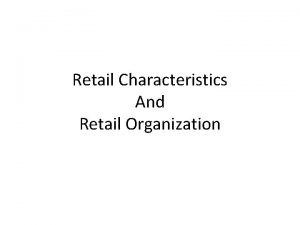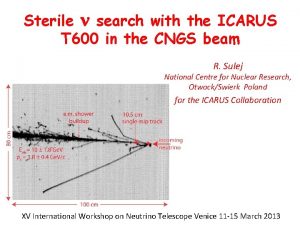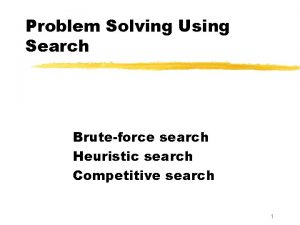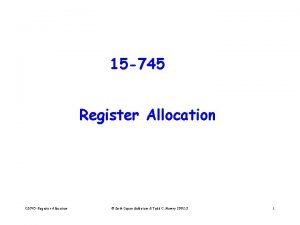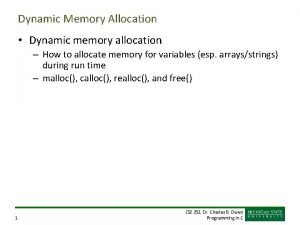ICARUS Intelligent Coupon Allocation for Retailers Using Search


























- Slides: 26

ICARUS: Intelligent Coupon Allocation for Retailers Using Search Stephen Swift 1, Amy Shi 2, Jason Crampton 3, Allan Tucker 1 1 SISCM, Brunel University, UK 2 Loyalty Logic Limited, Fleet, Hampshire, UK 3 Information Security Group, Royal Holloway, UK 1

Introduction (1) • Many retailers run loyalty card schemes • They offer incentives in the form of money off coupons • The total value of the coupons depends on how much the customer has spent 2

Introduction (2) This paper deals with the problem of finding the smallest set of coupons such that each possible total can be represented as the sum of a pre-defined number of these coupons 3

Introduction (3) For example, if the reward totals ranged between £ 2 and £ 6 The smallest set that can span all solutions is considered the best, i. e. {1, 2, 3} 4

Introduction (4) • A mathematical analysis of the problem is presented • Leading to a Genetic Algorithm solution • The algorithm is applied to real world data using several crossover operators • Compared to straw-person methods • Considerable time can be saved 5

Business Description (1) • Coupons mailed out every 4 -6 months • The reward value is a percentage of the customer’s expenditure • The expiry date and value is encoded as a barcode on each coupon • The number of coupons is fixed (very important!) 6

Business Description (2) • As small a number of denominations of coupons is needed – The barcode space (hence range of values) is small – A large number of coupon values will mean that the scheme will have to be redesigned too quickly 7

Business Description (3) £ Coupon 1 £ Coupon 2 Retailer Ltd. Dear Dr Swift, £ Coupon 3 £ Coupon 4 Some other money saving offers, such as fixed amounts off certain targeted products ………… 8

The Allocation Problem (1) • The monetary value of each coupon should be evenly distributed • “Good looking” numbers are preferred by customers, e. g. divisible by five • Coupon values should not exceed the typical basket value, which is between 9 £ 25 and £ 35

The Allocation Problem (2) An example of well-allocated coupons: Customer with total reward value of £ 20. 00 £ 2 £ 5 £ 10 : ü balanced ü good looking numbers ü values fit a typical basket Number of vouchers = 4 An example of badly allocated coupons: £ 1 £ 1 X not balanced X odd looking numbers X values are low/high for a typical basket £ 17 10

A Short Note • The problem would be trivial if: – The number of coupons required was not specified, e. g. 1, 2, 5, 10, 20, 50, 100, … – The number of overall coupon denominations did not have to be as small as possible 11

Mathematical Representation • We extensively use the fact that an instance of the problem can be split into several smaller instances • A recursive algorithm can be developed to see if a particular instance of the problem can be solved 12

ICARUS • ICARUS: Intelligent Coupon Allocation for Retailers Using Search • We solve the coupon allocation problem using a binary Genetic Algorithm (GA) • Find the smallest coupon set (A) that spans a given reward set V in m coupons 13

ICARUS - Representation • A Binary string where the length is application dependant (see paper) • A candidate coupon solution set is constructed from the corresponding chromosome, if gene i is 1 then the set A contains i • For 5 genes, 10101 : coupons {1, 3, 5} 14

ICARUS – Fitness Function Fitness = G(A) x H(V, m, A) (low is better) G(A) : Measures how “Good Looking” the values are H(V, m , A) : Measures how well A spans V (uses the recursive function) 15

ICARUS – Operators Crossover: Uniform, One Point & AND/OR Mutation: Binary Survival: Ranked 16

ICARUS – Post Processing • The recursive function can be used to generate all possible solutions for all reward totals • The “best” solution for each reward total can be selected either by the user or by using some criteria 17

Evaluation • Three Crossover operators • Simulated Annealing • Hill Climbing • The current manual results 18

Test Problem • A real world reward, run last year • 85 reward totals between £ 0 to £ 116 • m = 4 (number of coupons) • Additional post processing required 19

Results (1) 20

Results (2) 21

Results (3) 22

Results (4) 23

Concluding Remarks • We have presented a method for solving the reward scheme coupon allocation problem • This is achieved through the use of a binary Genetic Algorithm • The results show that ICARUS using one point crossover performs best • The ICARUS method runs in a few 24 minutes

Future Work • The ICARUS algorithm is really a prototype/proof of concept • The use of a Multi-Objective GA could be explored • It is intended that ICARUS be used to determine the next run for the retailer 25

Acknowledgements The authors would like to thank the unnamed retailer who provided the dataset used within this paper, Janet Mc. Fall for helpful comments and the reviewers for their constructive advice 26
 Contiguous allocation vs linked allocation
Contiguous allocation vs linked allocation Dynamic storage-allocation problem
Dynamic storage-allocation problem Types of retailers
Types of retailers Probability vs non probability sampling
Probability vs non probability sampling Types of retailers
Types of retailers Types of fashion retailers
Types of fashion retailers The number of merchandise categories a retailer offers
The number of merchandise categories a retailer offers Service retailers
Service retailers Types of retailers and wholesalers
Types of retailers and wholesalers Types of retailers
Types of retailers Vertical retail
Vertical retail Types of retailers
Types of retailers Classification of retailers
Classification of retailers Retail price management
Retail price management Fspos
Fspos Novell typiska drag
Novell typiska drag Tack för att ni lyssnade bild
Tack för att ni lyssnade bild Ekologiskt fotavtryck
Ekologiskt fotavtryck Varför kallas perioden 1918-1939 för mellankrigstiden
Varför kallas perioden 1918-1939 för mellankrigstiden En lathund för arbete med kontinuitetshantering
En lathund för arbete med kontinuitetshantering Personalliggare bygg undantag
Personalliggare bygg undantag Tidböcker
Tidböcker Sura för anatom
Sura för anatom Densitet vatten
Densitet vatten Datorkunskap för nybörjare
Datorkunskap för nybörjare Boverket ka
Boverket ka Debattartikel struktur
Debattartikel struktur
